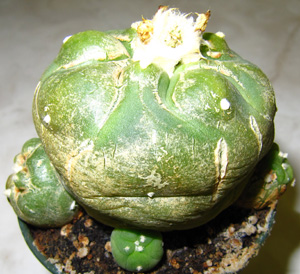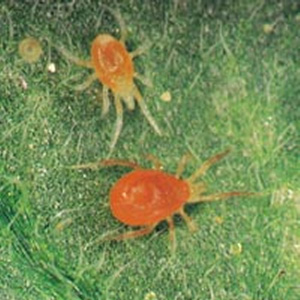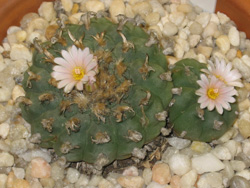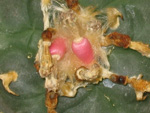|
Red Spider Mite Control
What Exactly Are Red Spider Mites:
The proper name for this pest is Tetranychus urticae, but it also goes by over 60 common names including that of red spider mite and two-spotted spider mite, and yes indeed they are actually members of the arachnid family. These little red devils are tiny, crawling, wingless, insects that have 6 or 8 legs depending on their stage of development, and measure about 0.5 mm in length. In fact they are so tiny, you need a ten power glass just to see them. Their presence is indicated by a very fine light speckling, or as localised pale yellow spots on the upper surfaces of leaves or in the case of cacti, plant bodies. Extensive damage is caused to leaves, buds and flowers with leaves eventually becoming bronzed, disfiguring plants for years to come and in severe cases causing plants to whither and die. These little red devils really do a number on your plants. Once they sink their teeth into your plant, the plant seems to go immediately into dormancy while they continue to eat away, and your plants will only wake up and begin growing again once you eradicate the problem. Have a look at a couple of my own mildly damaged plants in the pictures here below... it's a good thing I caught the problem early and hit the vermin hard.
 As you can see, there is plenty of new nice growth on this plant, since the problem was taken care of quickly, but the damage will still take a year or two before it hidden under the plant. As you can see, there is plenty of new nice growth on this plant, since the problem was taken care of quickly, but the damage will still take a year or two before it hidden under the plant.
 In this shot you can see a nice clean pup emerging along with new growth beginning to appear between the ribs of this badly damaged plant. In this shot you can see a nice clean pup emerging along with new growth beginning to appear between the ribs of this badly damaged plant.
What Colour Are They:
Most people would say they are red, but others say black, and even green. To set the record straight, a red spider mite is only red at certain stages of its life, when entering hibernation and in the springtime. A newly hatched mite is almost white, while the adult can be almost white in varying degrees through to green, with two spots on its back. These spots are said to be very dark green or dark red. The image here below must have been maginified a million time.

The Red Spider Mite Life Cycle:
Realistically, heat speeds up the life cycle of these dreaded parasites. It can be as short as three days in hot places, and as long as a month in cool weather with a dry atmosphere. As greenhouses tend warm up in the spring the breeding cycle begins, and will continue until autumn when plants begin to enter their dormancy cycle. The remaining females then turn RED and find places to hibernate in locations such as the soil or compost of the host plant, the bark of mature plants and even in the wood or brickwork of the building itself. Remember, they are so tiny that no crevice is too small. Then in the spring they show themselves once again as bright orangey red devils attacking your prize plants.
As mentioned, hot, dry conditions are often associated with an acceleration of spider mite infestations. Under optimal conditions of approximately 80ºF (25ºC), they can hatch in as little as 3 days and become sexually mature in as little as five days. Under such conditions, a single female can lay up to 20 eggs per day and can live for two to four weeks, laying hundreds of eggs that in the long run can create a population explosion within just one month of over a million little devils eating away at your plants. This accelerated reproductive rate allows spider mite populations to adapt quickly and build immunities to pesticide use over time. Cooler temperatures and a moist atmosphere is known to slow down their metabolism and slow the reproductive rate, so regular misting may help with control.
All spider mites go through the same stages of development. Adult females lay eggs on their host plants. The eggs hatch within days to weeks into the first stage called a larva with only three pairs of legs. The larva feed, then seek a sheltered spot to rest and moult into the first nymph stage having four pairs of legs. The nymphs then feed, rest and moult once again into the second nymph stage, feeding and resting before moulting into the adult stage. Males are smaller than females and have pointed abdomens, while females have rounded abdomens and are the largest mites present.
How Do You Recognise Them and Where Do You Look For Them:
As with most pests they are often found on the underside of leaves, but on cacti they tend to encompass the entire body. On close inspection of leaves, you will see the effects of the eggs from above, since the young hatchlings will eat away at the underside of the leaf, sucking the life out of the plant while leaving yellowish spot clusters showing through. On cacti though, these unsightly clusters of pin prick sized spots will begin showing themselves all over the plant body, eventually matting and looking like a great big tan coloured scar that can greatly reduce the photosynthetic capability of your plants, as well as the production of nutrients and possibly even killing it. As adults, spider mites colonise the plant and may also spin a very fine web over the leaf or plant and eventually to other plants in your collection. This webbing tends to act as a shelter for the young considerably reducing the effect of insecticides.
If you don't have a lens, you can identify these little red devils with a piece of bright white paper under direct sunlight, or a strong lamp by shaking the suspected leaves or plant itself over the paper and watching for very tiny specks scurrying to get to the other side. Mites are programmed to always go to the underside of a leaf if possible. Mite damage will appear on the lower, older sections of plants and leaves first.
Where Do Red Spider Mites Come From:
Considering that red spider mites stay on the same leaf or plant their entire lives, you might wonder how these pests get into your collections. Most seriously, they come from the pits of Hell, and praying will not help you. Noooo, seriously in short, theses little red devils hitchhike on birds, furry animals, people (mostly in the hair and clothing) and insects including that of white fly, aphids, wasps and big bumble bees. Take note that insects bring more disease and infestation into your household than any other method, and big bees can do considerable damage to your carefully tended show plants in a very short time with such devilish introductions.
Controlling Infestations of Red Spider Mite and Destroying Them:
1) Prevention is better than a cure, so place “bug screens” over open windows and doors to stop pests from entering. If you keep the bees out there is less chance of getting a Red Spider infestation.
2) Remove any infected plants immediately… and if you can afford to lose the plant, burn it alive so the infestation doesn't spread.
3) Check your plants regularly for any signs of infestation. Do not buy infected plants. And DON’T bring infected plants to any plant sales or shows. Also, do not invite people to your house that are known to have spider mite infestations... they might be acting as carries, and finally, do not be afraid to get out your magnifying glass and really check out any plants you are about to buy, it will save you a lot of time, effort, and expense.
4) If spider mites are found, try washing them off with a strong water sprayer. Mites, like aphids are easily dislodged from the leaf surface, at least before they have a chance to begin spinning their web. A regular hard blast of water once or twice a week can stop an infestation from occurring or slow it down once it starts, so long as you remember to spray the undersides of the leaves. Just hitting the top surface will do little or nothing, so concentrate your attention on the lower parts of plants as well as any crevices they might crawl into.
5) Improve the conditions in your greenhouse with misting and cooler temperatures if possible.
6) Using insecticides, and insecticidal soaps to control Red Spider Mites. Some people regard chemical sprays as less effective, but Polysect is reputed to be a good control against mites and other pests. Read the label carefully as you will see that differing strength mixes are required for various pests. Another fairly good insecticidal soap would be Safer's miticide, (Safer's End All, most specifically the concentrated solution), or if you can find it, Safer's End All for red spider works very well. The big problem is that there are few effective egg killers for mites, so you must follow up in five to seven days with a repeat treatment to kill the hatchlings. Usually three treatments are necessary to end an infestation. Do not use more or less than the recommended amount or concentration. Using less can result in breeding mites with a resistance to the specific chemical.
Adding a little insecticidal soap and methylated spirits to the water in your mister will also aid in the battle against this most persistent pest. Remove the webs and the spider mites by washing the plant in soapy tepid water, paying particular attention to the underside of all the leaves. Repeat the treatment every 3 to 4 days to ensure its success. For tough plants, a forceful jet of water can be used to rinse. Washing will not always remove all the eggs so repeat on a weekly basis until the plant is clear. For severe infestations it is best to destroy the plant.
Use miticides for heavy infestation that are specifically used to control red spider mites. Insecticides against normal bugs are ineffective in killing red spider mites, and may aggravate the problem as the insects that eat the mites are killed by the chemicals instead. Miticides (acaricides) can be purchased at garden centers but the best ones require a license.
Another method discovered by one of our own members of the Toronto Cactus and Succulent Club that has proven rather effective is the use of mythel hydrate found in the paint section of most hardware stores. This product can be sprayed directly on the plant and kills red spider mites on contact without harming your plants. Repeat the treatment every three to four days until the situation is under control... only three to five applications needed.
7) Hot pepper wax, which is sprayed to prevent transpiration is another remedy which smothers the adults on the leaves, but does not kill the eggs so be prepared to repeat applications every four to five days until control is established. Mites need to expire a lot of moisture from their bodies to survive. Hot pepper wax is also a brilliant repellent to white, black and greenfly, as they do not like the peppery flavour. Cayenne powder, sprayed onto the surface of the compost in your pots, is also reputed to deter crawling insects and sciarid flies.
8) If you have a marked or damaged leaf take it off without too much disturbance and check it out. Chances are you will be getting rid of a major headache about to unfold.
9)Switch to slow-release or lower-nitrogen fertilizers. High levels of nitrogen in the leaves can increase spider mite reproduction rates.
10) For truly eradicating, and I do mean wiping out the entire population of red spider mites you have to go the route of Genghis Khan and introduce your own army of little predators. Spider mites have many natural enemies such as mantis, dragonfly, wasp, spider, caterpillar, ladybugs and the most famed red spider killer is a mite called phytoseiulus persimilis. Phytoseiulus persimilis was accidentally introduced from Chile on a shipment of orchids in 1958. These mites (phytoseiulus persimilis) are fast moving predatory mites and the principal biological control for greenhouse red spider mite. The adult phytoseiulus are slightly larger than red spider mites with longer legs and an orangey red body. They move rapidly over plants, searching for their prey and each individual can consume 5 adults or 20 immature stages of red spider mite per day. Predatory mites eat adult mites, their eggs, pupae and all developmental stages in between.
Predators and predatory mites can be introduced at any time, but best in the spring when mites begin appearing and building their populations. Early introduction of predators have proven far more effective than bringing them into an infested population, and considering the expense this is also a cost effective procedure. Predators can eradicate red spider mites populations quickly provided they are introduced early. Once predators gain control and have eaten all the little red devils, most become cannibals and eat each other until they too have all gone. Predators can be a bit expensive, but worth it if it saves your prize plants. The secret here is to introduce predators before the problem gets out of hand. If you do use predators you will have to stop using insecticides, as they can kill your beneficial insects as well. There are several species available that are adapted to a particular climate. They have a rather narrow range of humidity and temperature requirements, so research what might suit you best.
A great many mites in the family of Phytoseiidae are predators of spider mites. Among those most commonly sold via mail order are Galendromus occidentalis, Phytoseiulus persimilis good for about 90 degrees Fahrenheit and is the most recommended, Metaseiulus occidentalis being most effective with temperatures ranging from 44 to 89 degrees Fahrenheit, Phytoseiulus longpipes is a variant of Phytoseiulus persimilis but brought in from Africa and can withstand warmer ambient temperatures, then we have Mesoseiulus longpipes, Amblyseiulus fallicus and Neoseiulus californicus to choose from.
Most predators are kept in the fridge to keep them dormant until it's time to work. Predators are then released in small numbers in the most affected areas, either once the sun goes down, or after the lights go off if your plants are kept indoors, because both predators and their larva feed mostly at night, and the heat given off by your lights could kill them.
Another recommended predator of these little red devils as mentioned previously are Ladybugs, which are far more plentiful, less expensive, sold over the Internet and easily found at local nurseries. The best in the species for red spider control is said to be the Stethorus species but most will do. When using ladybugs it is recommended that a solution of one half Coke to water is sprayed on them to glue their wings down so that they walk all over your plants looking for food instead of flying away.
Here below is a link to a recommended supplier of predators located in Ontario:
Natural Insect Control: Owned and operated by Dave Mitchell
http://www.natural-insect-control.com/

email: dr_frank @ magicactus.com
Mailing
address:
Frank
Valente
MagiCactus.com
56 Dewhurst Blvd.
Toronto, Ontario
M4J 3J3
© 2008, Frank Valente |



